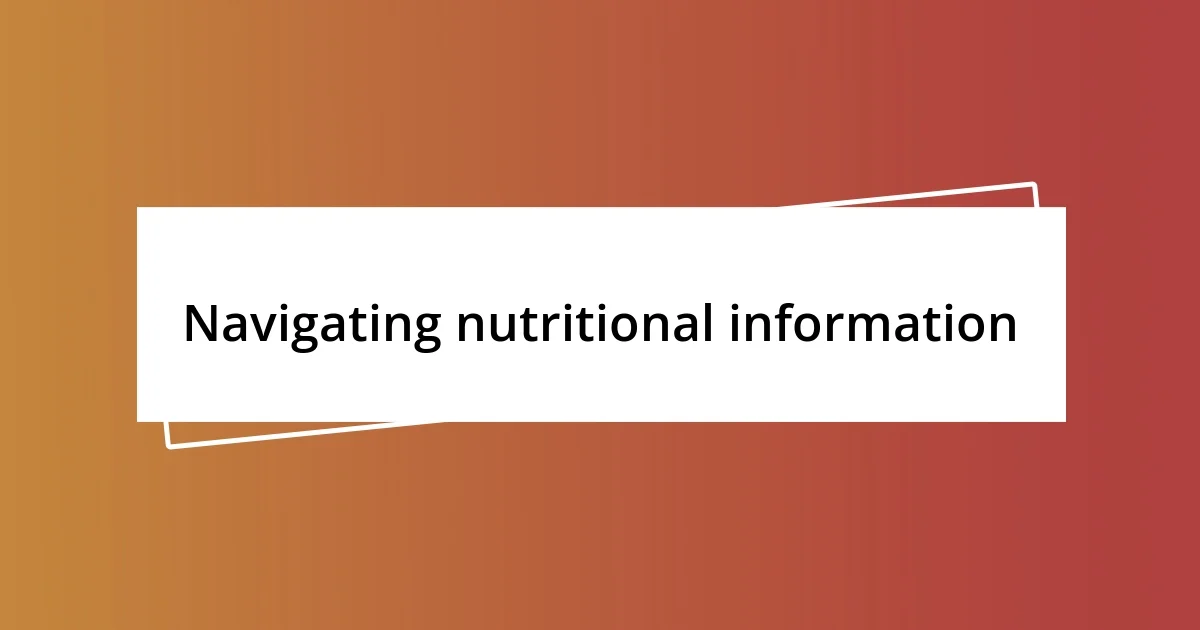Key takeaways:
- Understanding food labels, including serving sizes and ingredient lists, is crucial for making informed dietary choices and managing nutrition effectively.
- Be cautious of health claims on packaging, as they can be misleading and do not always guarantee healthier options; always check the full nutritional details.
- Focusing on simpler ingredients and familiarizing yourself with common terms can enhance your grocery shopping experience and promote healthier eating habits.

Understanding food labels basics
Understanding food labels can feel overwhelming at first, but once I broke it down into manageable parts, it became second nature. For instance, when I first looked at a label, I couldn’t wrap my head around ingredients like high-fructose corn syrup or monosodium glutamate. I often wondered, “Why are there so many unfamiliar words?” My curiosity pushed me to research, and I found that some ingredients are just additives that enhance flavor or shelf life, which helped me feel more comfortable navigating labels.
Serving size is another key element that deserves a closer look. I remember buying a bag of chips and thinking, “Wow, this doesn’t seem like a lot for 150 calories!” It wasn’t until I realized that the serving size was actually only 10 chips that I understood the math behind the numbers. Has that ever happened to you? Recognizing serving sizes changes the way we perceive portions and makes it easier to stay in tune with our dietary goals.
Let’s talk about the nutrition facts panel, which is where the real magic happens. When I first started reading them, I focused solely on the calorie count, but then I learned to scan for sugar, sodium, and fiber, which made a significant difference in my choices. Seeing the percentage of daily values next to each nutrient made me think, “Am I really getting enough nutrients in my meals?” This realization turned me into a more conscious shopper, urging me to choose healthier options that aligned with my eating habits.

Importance of reading food labels
Reading food labels is important because it empowers us to make informed choices about our diet. I vividly remember the first time I genuinely examined a food label; it was on a box of cereal. I was shocked to discover how much added sugar was packed into what I thought was a wholesome breakfast option. Seeing those numbers changed my entire perspective on what I was consuming daily. I realized that simply being aware of the contents helps in making better overall dietary decisions.
Furthermore, understanding food labels can lead to significant health benefits. When I started paying attention to fats and carbohydrates, I experienced a noticeable improvement in my energy levels. An incident that stands out is when I made a switch from a regular yogurt to a low-sugar alternative after reading the label. The taste wasn’t drastically different, but the health benefits were significant, making my meals both enjoyable and nutritious.
Comparing different products also showed me the value of reading labels. Each time I stood in the grocery aisle, I found myself doing a mini-analysis between options. For instance, I once compared two brands of pasta sauce side by side. One had double the sodium content, and it was enlightening to realize how similar products could vary significantly. This habit became a ritual for me, transforming grocery shopping into a fun challenge.
| Aspect | Importance |
|---|---|
| Understanding Nutritional Values | Helps identify the actual benefits of food. |
| Monitoring Ingredients | Enables avoidance of unhealthy additives. |

Key components of food labels
When I began peeling back the layers of food labels, I discovered that every component serves a purpose. The first thing that caught my eye was the ingredients list. At first, it felt like deciphering a foreign language, but I quickly learned that the order matters: ingredients are listed from most to least abundant. I remember being surprised to find that my favorite granola had more sugar than oats! That revelation sparked a curiosity to dig deeper into each item on the list.
Here are some key components to keep an eye on:
- Ingredients List: Lists all ingredients in descending order by weight, highlighting what’s predominant in the product.
- Serving Size: Indicates how much of the product is typically consumed in one sitting, essential in calculating calories and nutrients.
- Nutritional Facts Panel: Displays key nutrients like calories, fats, sugars, and vitamins, often expressed as a percentage of the daily value, helping track dietary needs.
- Allergy Information: Alerts consumers to common allergens, ensuring safe choices for those with food sensitivities.
- Expiration Date: Indicates freshness, which is crucial for both safety and taste. I’ve found that disregarding this can lead to unpleasant surprises!
Learning to read food labels involves recognizing patterns that guide healthier choices. For instance, I often check for added sugars and saturated fats, which have a sneaky way of popping up where you least expect them. One day, I came across a seemingly innocent can of soup that promised “reduced sodium,” but when I checked the label, I was shocked to find that it still contained more salt than I typically added to my homemade recipes! Understanding those key components transformed my shopping habits entirely. Now, I feel empowered making choices that contribute to my well-being.

Navigating nutritional information
Navigating nutritional information can initially feel daunting, but I’ve found that it becomes much easier with practice. When I first confronted the nutritional facts panel, I was overwhelmed by the percentages and numbers. However, I learned to focus on a few key metrics that truly matter. For instance, understanding that 5% of your daily value is low and 20% is high has become my quick reference in assessing whether a product is worth my time, or if I should put it back on the shelf.
I remember a moment when I was comparing two salad dressings—a classic light versus a creamy option. I hesitated as I scanned the labels. While the light dressing boasted fewer calories, it also had a long list of additives I couldn’t even pronounce. This made me realize that sometimes less can be more; the richer dressing contained fewer ingredients and healthier fats. Choosing it felt like a victory, reinforcing my belief that quality often outweighs quantity.
Have you ever figured out that the foods you assume are healthy might not be? For example, I used to think those shiny, health-focused snack bars were great choices until I took a closer look. Discovering that some labeled “natural” or “healthy” were filled with hidden sugars and preservatives was an eye-opener for me. This experience taught me that reading the nutritional information isn’t just about counting calories; it’s about making choices that nourish my body. Engaging with these labels has truly helped me navigate my journey in healthier eating.

Identifying health claims accurately
I’ve realized that health claims on food packaging can be misleading, often designed more for marketing than for clarity. For instance, when I first saw a granola bar labeled “heart-healthy,” I assumed it was a good choice. However, after a little digging, I found out that the claim was based solely on its use of oats. This led me to question what other claims might be glossing over important details. Have you ever stopped to think about what “low-fat” or “fortified” really means? It’s definitely worth investigating!
One particularly frustrating moment came when I picked up a juice that boasted “no added sugars.” Sounds great, right? But then I noticed it was crammed full of natural sugars from fruit concentrates. I felt deceived and a little angry with myself for not looking closer. This taught me that health claims often require a deeper look, as they can mask questionable ingredients. Now, I take each health claim with a grain of salt and always check the full nutritional details.
It’s so empowering to sift through these claims and uncover the truths behind them. I remember feeling a sense of victory when I discovered that a seemingly healthy product was actually filled with additives. This realization sparked a desire to educate myself further and become a more informed consumer. So, next time you see a health claim, ask yourself: what’s the story behind it? Digging deeper not only enhances your knowledge but also puts you firmly in control of your health choices.

Common misconceptions about food labels
I’ve often heard people say that “organic” labels guarantee healthier options, but I’ve learned that’s not necessarily true. One time, I excitedly grabbed a bag of organic chips, thinking they were a guilt-free snack. When I looked closer, I discovered they were still loaded with salt and unhealthy fats. It made me wonder, how often do we cling to labels without really understanding what they represent?
Another common misconception is that all “sugar-free” products are automatically good for you. I remember picking up a dessert labeled as “sugar-free,” celebrating what I thought was a healthy choice, only to find it packed with artificial sweeteners. That experience made me realize that a lack of sugar doesn’t mean a lack of calories or unhealthy ingredients. This put me in a position to reassess my approach to sugar substitutes—what are they really doing to my body?
Then there’s the notion that serving sizes on food labels are unimportant. I once mindlessly consumed a whole bag of snack-sized bags labeled as “one serving.” When I looked at the nutritional info, I realized that I had unwittingly doubled my calorie intake! It hit me that understanding serving sizes is essential for managing my overall nutrition. Have you ever experienced a similar situation that made you rethink your assumptions about food labels? Reflecting on these truths has truly helped shape my eating habits for the better.

Practical tips for label reading
I find that one of the most practical tips for reading food labels is to focus on the ingredient list. The fewer the ingredients, the better. I remember picking up a jar of pasta sauce with a long list of unfamiliar words and preservatives. At that moment, I realized that simpler is often healthier. Have you ever compared a homemade sauce recipe to what’s on the shelf? It can be quite eye-opening!
Another helpful strategy is to pay attention to the first few ingredients listed—these make up the bulk of the product. For instance, when I switched to a new bread brand, the first ingredient was whole wheat flour. That made me feel good about my choice. However, I was shocked to see sugar listed as the third ingredient! This taught me to keep a discerning eye on the overall composition of a product, not just the appealing name on the front label.
Lastly, I can’t stress enough how valuable it is to familiarize yourself with common terms. Understanding what “hydrogenated oils” or “high fructose corn syrup” really means can change your grocery shopping habits dramatically. I still recall the moment I discovered that those words indicated unhealthy additives—I felt a mix of anger and empowerment. Why aren’t we taught more about these terms? Engaging with this knowledge not only protects your health but also arms you with confidence on your journey to better eating.














